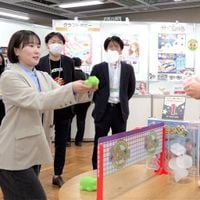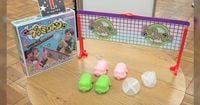The Toy Business Fair, a prominent trade show for the toy industry, recently showcased a striking trend: toys that evoke nostalgia while appealing to modern sensibilities. Among the highlights of this year's fair was the revival of the beloved game 'Buta no Tonton,' also known as 'Buta-Minton,' which originally hit the shelves in 1987 and saw a resurgence in 2004. Now, after a 21-year hiatus, this classic game is making a comeback, much to the delight of both nostalgic adults and curious children.
Held during the Golden Week, the Toy Business Fair brought together 52 manufacturers and featured over 4,700 toys, all vying for attention in a competitive market. According to the Toy Business Fair Executive Committee, one of the standout trends this year is the rise of toys that blend nostalgia with new twists. Remakes of popular toys from the Showa and Heisei eras, as well as those incorporating retro elements, have captivated attendees.
One of the most talked-about products at the fair was the 'PRINT CAMERA Prica,' priced at 8,800 yen. This innovative toy camera prints monochrome photos on thermal paper, a design inspired by the trend of 'receipt photos' that has gained popularity among young people in South Korea. The camera boasts features like a built-in ring light for enhanced lighting and a rotating lens for selfie capabilities. Additionally, it comes with 60 different character frames to personalize the prints.
What sets the 'PRINT CAMERA Prica' apart is its intentionally rough pixel quality. In an era where high-resolution smartphone cameras dominate, the creators aimed to evoke a sense of nostalgia and emotion with the grainy monochrome images. A representative from the manufacturer explained, "By intentionally making the pixels a bit rough, we aim to enhance the emotional appeal of the photos." This approach resonates with those seeking a more authentic and less polished representation of their memories.
The revival of 'Buta no Tonton' is particularly noteworthy. The game, which combines elements of badminton and humor, was a staple of childhood for many Japanese adults. The product manager shared that the goal of reintroducing the game is to create a product that feels nostalgic to adults while still being fresh and exciting for today's children. "For adults, it’s nostalgic; for today’s kids, it’s something new," the manager stated.
The original 'Buta no Tonton' was a hit in the late 1980s and early 2000s, known for its quirky design and playful nature. The game involves players using a pig-shaped shuttlecock, adding a whimsical twist to traditional sports games. The revival comes at a time when many are seeking ways to engage with their childhood memories, and the marketing strategy appears to be resonating well with both former players and a new generation.
Social media reactions to the announcement of the game's return have been overwhelmingly positive. Many users took to platforms like Twitter to express their excitement and share fond memories of playing 'Buta no Tonton' in their youth. Comments ranged from nostalgia-laden anecdotes to humorous reflections on the game's unique mechanics. One user reminisced, "I remember playing this game during Christmas with my family!" while another added, "It was so much fun; I can't wait to play it again!"
As the toy industry continues to evolve, the blending of nostalgia with innovation seems to be a winning formula. The Toy Business Fair not only highlighted the importance of catering to the emotional connections consumers have with toys but also showcased the potential for older products to find new life in a modern context. The successful revival of 'Buta no Tonton' serves as a reminder that sometimes, looking back can lead to exciting new opportunities.
With the fair setting the stage for upcoming trends, it's clear that the toy market is embracing a strategy that prioritizes emotional connections and nostalgic experiences. Whether through the playful revival of classic games or innovative new products, the industry is poised to capture the hearts of consumers across generations. As the summer holidays approach, families can look forward to rediscovering the joy of play with these beloved toys, bridging the gap between past and present.





